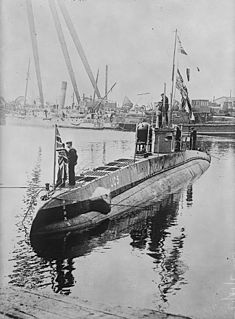U-116 may refer to one of the following German submarines:

Germany, officially the Federal Republic of Germany, is a country in Central and Western Europe, lying between the Baltic and North Seas to the north, and the Alps to the south. It borders Denmark to the north, Poland and the Czech Republic to the east, Austria and Switzerland to the south, France to the southwest, and Luxembourg, Belgium and the Netherlands to the west.
- U-116, a German Type U-115 submarine built by Schichau in Danzig. Never completed she was broken up and her main engines used in SMS Gefion.
- SM UB-116, a Type UB III submarine launched in 1917 for service in the First World War and was sunk on 28 October 1918 at Scapa Flow
- German submarine U-116 (1941), a Type XB submarine that served in the Second World War and went missing in October 1942
SM U-116 was a German Type 115 U-boat of the Imperial German Navy built at Schichau-Werke, Danzig. As her sister ship SM U-115, she was never completed and ultimately broken up in Danzig after the Armistice with Germany. Her main engines were used in M/S Adolf Sommerfeld ex SMS Gefion. Both boats had been offered to the IGN free of charge by Schichau in an attempt to gain experience in building submarines.

SMS Gefion was an unprotected cruiser of the German Kaiserliche Marine, the last ship of the type built in Germany. She was laid down in March 1892, launched in March 1893, and completed in June 1895 after lengthy trials and repairs. The cruiser was named after the earlier sail frigate Gefion, which had been named for the goddess Gefjon of Norse mythology. Intended for service in the German colonial empire and as a fleet scout, Gefion was armed with a main battery of ten 10.5-centimeter (4.1 in) guns, had a top speed in excess of 19.5 knots, and could steam for 3,500 nautical miles, the longest range of any German warship at the time. Nevertheless, the conflicting requirements necessary for a fleet scout and an overseas cruiser produced an unsuccessful design, and Gefion was rapidly replaced in both roles by the newer Gazelle class of light cruisers.

SM UB-116 was a German Type UB III submarine or U-boat in the German Imperial Navy during World War I. She was commissioned into the German Imperial Navy on 24 May 1918 as SM UB-116.
| This article includes a list of ships with the same or similar names. If an internal link for a specific ship led you here, you may wish to change the link to point directly to the intended ship article, if one exists. |


